In the fascinating world of electric guitars, the pickup selector switch is a pivotal component that often gets overlooked. This tool gives musicians the ability to manipulate and refine their sound by controlling which pickups are active, thereby providing a spectrum of tonal possibilities, especially when combined with the tone controls.
What does the pickup switch do on an electric guitar?
The pickup switch on an electric guitar allows the player to select which pickups are active, thereby altering the tone and output of the guitar. This selection can range from a single pickup to a combination of two or more, depending on the guitar’s configuration.
This article will look into the various types of pickup selector switches, discussing how they function in several iconic guitar models, from the classic Fender Mustang and Stratocaster to the versatile Ibanez and the distinctive Gretsch.
Through this exploration, we aim to equip you with a deeper understanding of your instrument, enabling you to unlock its full potential.
Stay tuned, and let the exploration of your guitar’s tonal landscape begin!

What Does The Pickup Switch Do On An Electric Guitar?
The pickup switch on an electric guitar allows you to select between different pickups. The pickups are magnets that “pick up” the vibrations of the guitar strings and convert them into an electrical signal, which is then amplified to produce sound.
Different pickups can produce different tones, so the switch gives you the ability to change the tone of the guitar while you’re playing.
Here’s a bit more detail on the types of pickups and what the switch can do:
- Single-coil pickups: These are made from a single coil of wire wrapped around a magnet. They produce a bright, crisp sound, but they can also pick up interference from other electrical devices, which can cause a humming sound.
- Humbucker pickups: These are made from two coils of wire wrapped around a magnet, with the coils wired in such a way that they cancel out the interference that single-coil pickups pick up. This means they don’t produce the humming sound that single-coil pickups do, but they also produce a warmer, richer sound.
Many guitars have multiple pickups – often a combination of single-coil and humbucker pickups – located in different positions along the length of the strings.
The pickup closest to the guitar’s neck (the “neck pickup”) will pick up more of the strings’ lower-frequency vibrations, producing a warmer tone, while the pickup closest to the bridge (the “bridge pickup”) will pick up more of the strings’ higher-frequency vibrations, producing a brighter tone.
The pickup switch allows you to select which pickup(s) you’re using. A typical configuration might be:
- Position 1: The neck pickup only (for a warm tone).
- Position 2: The neck and middle pickups together (for a balanced tone).
- Position 3: The middle pickup only (for a slightly brighter tone).
- Position 4: The middle and bridge pickups together (for a bright tone with some warmth).
- Position 5: The bridge pickup only (for a bright, twangy tone).
Please note that the above is just an example – the exact configuration will depend on the specific guitar and how it’s wired.
How To Use Pickup Selector Switch?
The pickup selector switch is a tool to shape the sound of your electric guitar. Here’s how you can use it:
1. Understand Your Guitar’s Pickup Configuration: Before you start, it’s important to understand your guitar’s pickup configuration. Most commonly, guitars have either two or three pickups.
The configuration of the pickup selector switch will depend on the number and arrangement of the pickups.
2. Learn The Positions of The Switch: Next, you need to learn the positions of the switch. These positions correspond to different combinations of the pickups. Here’s a general guide for a three-pickup guitar (e.g., a Stratocaster):
- Position 1: Bridge pickup only. This will give a bright and cutting tone, often used for lead lines.
- Position 2: Bridge and middle pickups. This will give a balanced tone between bright and warm.
- Position 3: Middle pickup only. This gives a balance between the brightness of the bridge pickup and the warmth of the neck pickup.
- Position 4: Middle and neck pickups. This gives a warmer, fuller sound.
- Position 5: Neck pickup only. This gives the warmest tone, which is often used for rhythm guitar.
For a two-pickup guitar (e.g., a Les Paul), the switch usually has three positions:
- Position 1: Bridge pickup only.
- Position 2: Both pickups.
- Position 3: Neck pickup only.
3. Practice and Experiment: Start by playing with the switch in each position and listening to the difference in sound. Try playing the same riff or chord sequence in each position to really hear the difference.
The more you play with the switch, the more you’ll get a feel for the kind of sound each position produces.
4. Use the Switch to Suit Your Playing: Once you’re familiar with the sound of each position, you can start using the switch to shape your sound to suit your playing.
For example, you might use the bridge pickup for a bright, cutting solo, then switch to the neck pickup for a warm, full rhythm part.
There are no hard and fast rules about how to use the pickup selector switch. The best way to learn is to experiment and find the sounds that you like best.
What Are The Types Of Guitar Switch Configurations?
There are several types of guitar switch configurations, determined by the number of pickups on the guitar and the style of the guitar itself. Here are some of the most common types:
- Three-Pickup Configuration (e.g., Stratocaster Style): These guitars have three pickups (often single-coil) – one near the neck, one in the middle, and one near the bridge. The pickup selector is typically a 5-way switch:
- Position 1: Bridge pickup only.
- Position 2: Bridge and middle pickups together.
- Position 3: Middle pickup only.
- Position 4: Middle and neck pickups together.
- Position 5: Neck pickup only.
- Two-Pickup Configuration (e.g., Les Paul Style): These guitars have two pickups (often humbuckers) – one near the neck and one near the bridge. The pickup selector is typically a 3-way switch:
- Position 1: Bridge pickup only.
- Position 2: Both pickups together.
- Position 3: Neck pickup only.
- Telecaster Style: Telecasters typically have two pickups (both single-coils) and a 3-way switch, but the wiring is a bit different:
- Position 1: Bridge pickup with treble tone cut (darker sound).
- Position 2: Both pickups together in parallel (brighter sound, but still somewhat warm).
- Position 3: Neck pickup only (warmest sound).
- Super Strat Style: Some modern guitars, often referred to as “Super Strats”, have three pickups but with a humbucker in the bridge position and single coils in the middle and neck positions. The pickup selector is usually a 5-way switch, like a regular Stratocaster.
- Custom and Varied Configurations: Some guitars have more unique or complex wiring configurations.
For example, some guitars have four pickups, or a mix of different types of pickups. Some have more than one pickup selector switch, or additional switches to split a humbucker into a single coil, phase switches, or other tonal variations.
The PRS 5-way blade switch, for instance, offers a variety of tonal options by combining pickups and splitting coils in different ways.
Some guitars also feature a blend knob, allowing for continuous blending between pickups, rather than the stepped selection of a switch.
Understanding your guitar’s switch configuration is key to exploring its full range of tones.
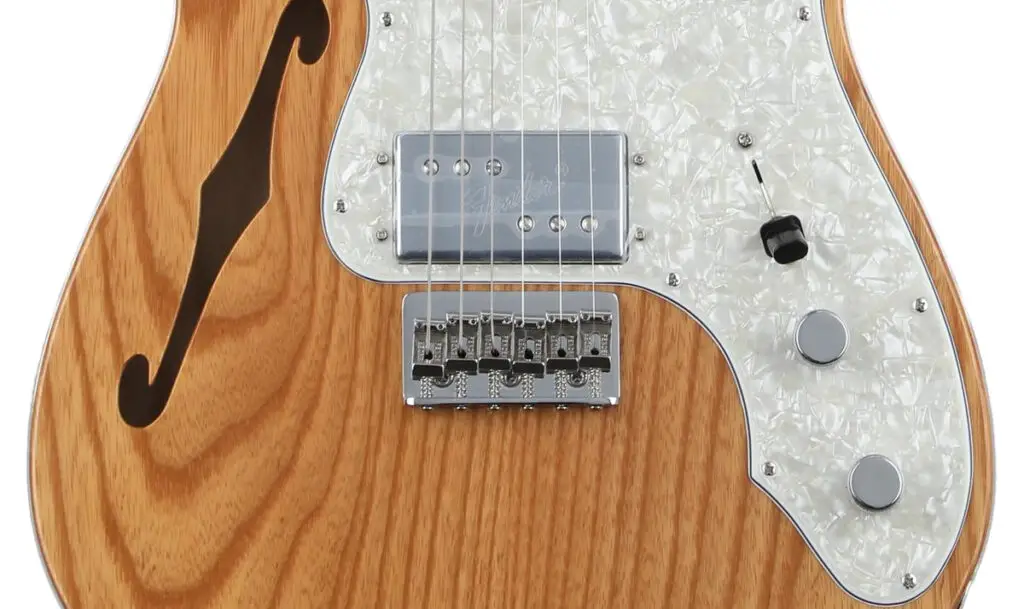
Telecaster Pickup Switch
The Fender Telecaster, one of the most iconic electric guitars, typically has a two-pickup configuration with a 3-way selector switch. Here’s how the switch positions usually work:
- Position 1 (Towards the bridge): This position activates the bridge pickup only. The sound in this position is bright and twangy, which is often associated with country music but is also used in many other genres.
- Position 2 (Middle): This position activates both the bridge and neck pickups. The sound here is a blend of the two pickups, providing a balanced tone that is not as bright as the bridge pickup alone, but not as warm as the neck pickup alone.
- Position 3 (Towards the neck): This position activates the neck pickup only. The sound in this position is warm and full, which is often used for jazz and blues, but again, is versatile enough for many genres.
The naming convention for the positions may vary. Some players may refer to the position towards the bridge as position 1, and others may refer to the position towards the neck as position 1. The descriptions I gave assume the former, which is more common.
The exact tone you get from each position can be affected by other factors, like the specific model of the Telecaster, the type of pickups it has, the setting on the tone knob, the type of strings, the amplifier and effects used, and the technique of the player.
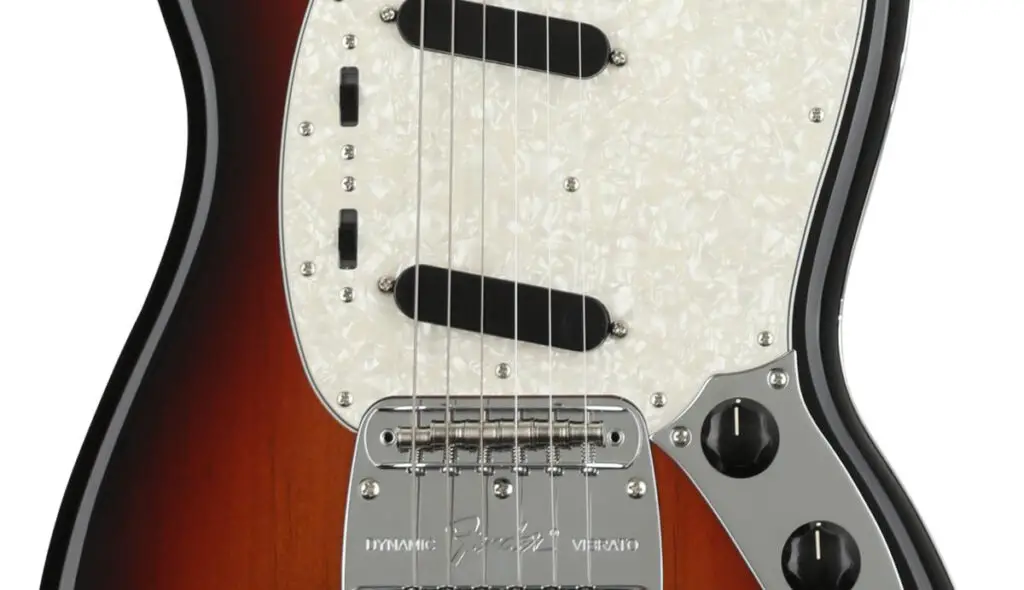
Fender Mustang Switch Positions
The Fender Mustang has a unique switch configuration that differs from most other guitars. The original wiring of a Fender Mustang involved two switches, each connected to one of the pickups.
These switches offered the following settings:
- Pickup engaged in phase
- Pickup off
- Pickup engaged out of phase
This setup allowed for a total of eight different sounds. You could use the pickups either alone or in parallel and either in or out of phase when played together.
Over the years, many modifications have been made to the Mustang’s wiring to make it more user-friendly and to provide a wider range of tones.
One common modification involves converting one of the switches into a conventional pickup selector switch, yielding three combinations:
- Bridge pickup alone
- Bridge plus neck pickup in parallel and in phase
- Neck pickup alone
This configuration is similar to the switching matrix found on most Telecasters. The second switch is often converted to a preset switch. When set closest to the neck, this preset switch overrides the 3-way pickup selector switch.
For these modifications, it is recommended to use 250k audio pots and a 0.022 µF tone cap. This setup provides a tonal palette suitable for almost all styles of music. However, if you require the Mustang’s original phase in/out option, this modified wiring may not be suitable for you.
Premier Guitar has a guide for rewiring a Fender Mustang.
If you’re curious about the history of the Mustang, check out this guy’s website: MrMaxima.

Fender Stratocaster Push Button Pickup Selector
The Fender Stratocaster, specifically the Deluxe Strat, has a unique push/push mini-switch that adds to the flexibility of the traditional five-way pickup selector switch. Here’s how it works:
When the push/push switch is not engaged:
- Position 1: Bridge pickup only
- Position 2: Bridge pickup and middle pickup together
- Position 3: Middle pickup only
- Position 4: Middle pickup and neck pickup together
- Position 5: Neck pickup only
When the push/push switch is engaged:
- Position 1: Bridge pickup only
- Position 2: Bridge pickup and middle pickup together
- Position 3: Middle pickup only
- Position 4: Bridge pickup, middle pickup, and neck pickup together
- Position 5: Bridge pickup and neck pickup
The addition of the push/push mini-switch activates the bridge pickup when the pickup selector is in positions four and five, enhancing the Strat’s already flexible sound from the Vintage Noiseless pickups. More information can be found on Fender’s blog about the switches.

Ibanez 5-Way Pickup Selector Switch
Ibanez has so many different configurations, but this is a very popular configuration.
Ibanez guitars use a proprietary 5-way switch (Alpha 2502N) to control their pickups. This switch allows for a variety of different sounds, with each setting being usable and hum-canceling.
Here is the function of a 5-way switch on an Ibanez guitar with two humbucker pickups based on typical configurations:
- Position 1: Bridge pickup only, typically with both coils active for a full humbucker sound.
- Position 2: A combination of the bridge and neck pickups, often with one of the pickups split to use only one coil, which can give a unique tone.
- Position 3: Both the bridge and neck pickups are active. This position often uses both coils of each pickup for a full, rich sound.
- Position 4: Similar to position 2, but typically with the other pickup split.
- Position 5: Neck pickup only, usually with both coils active for a full humbucker sound.
These positions can provide a wide range of tones, making the 5-way switch a versatile tool for shaping the sound of the guitar. The specific functions can vary depending on the particular model of the guitar and how its electronics are configured.
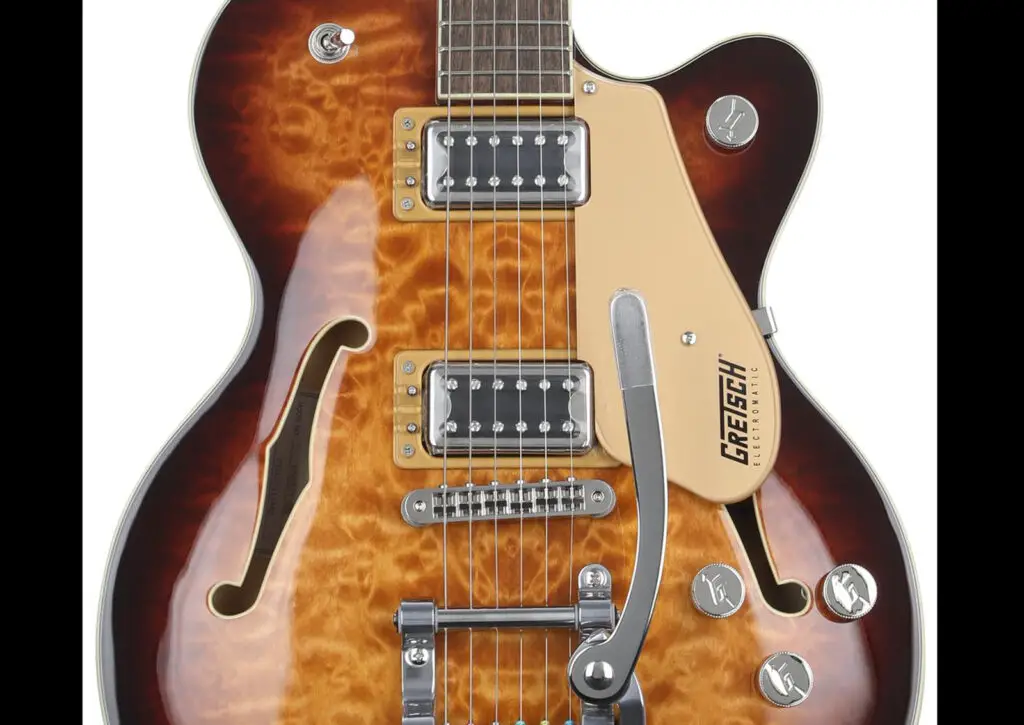
Gretsch Pickup Selector Switch Positions
Gretsch guitars use different control arrangements depending on the model. In general, the pickup selector switch is used for selecting the pickup position.
- Players Edition (“No-Load Tone-Pot Circuit”), Arrangement #1 (“Tone-Pot Circuit”), Arrangement #2 (“Tone-Switch Circuit”), and Arrangement #3 (“Tone-Switch Circuit with Standby”) all have the following settings:
- Rear position for the neck pickup
- Middle position for both pickups.
- Front position for the bridge pickup.
For more information, Gretsch provides a control guide that can be found online.
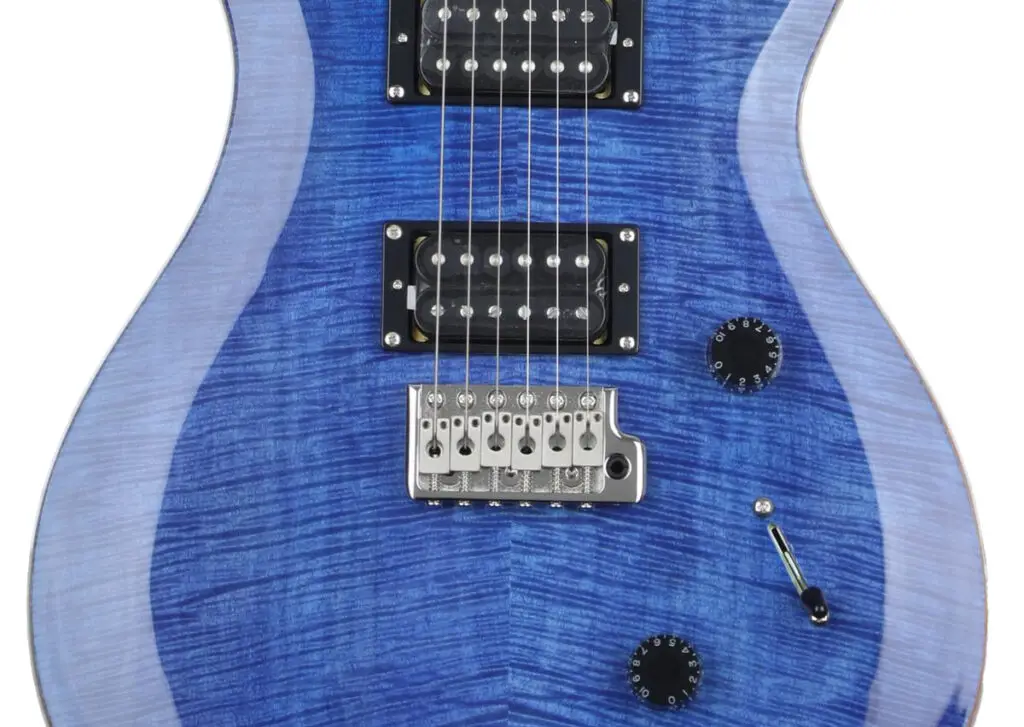
PRS SE Custom 24 Switch Positions
The PRS SE Custom 24 uses a 5-way blade switch, with the following configurations:
- Position 1: Bridge humbucker
- Position 2: Bridge humbucker with neck single coil
- Position 3: Bridge and neck humbuckers
- Position 4: Neck single coil with bridge single coil
- Position 5: Neck humbucker.
More information about the switch can be found on the PRS website.
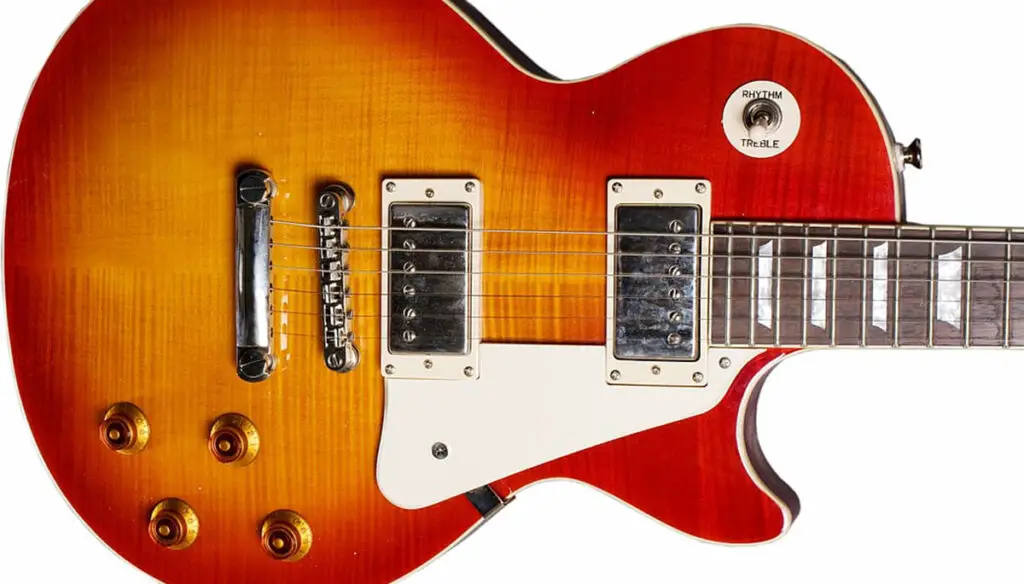
Gibsons: Switchcraft Pickup Selector Switch
The Switchcraft pickup selector switch is a premium-grade switch used primarily in guitars as pickup switches.
This switch is relied on by some of the largest names in the guitar industry for its quality and durability. The switches can be bought directly from Switchcraft. It’s worth noting that knobs for these switches must be ordered separately.
The 12000 series is used in Gibson guitars, in particular the Les Paul and SG models.
The 11000 series can be found in Fender Mustang, Jaguar, and Jazzmaster guitars.
Conclusion
As we’ve journeyed through the complexities and functionalities of various pickup selector switches, it’s clear to see how this small component can significantly shape the sound and character of an electric guitar.
From the vintage tonalities of the Fender Mustang, the innovative push/push mini-switch of the Fender Deluxe Strat, the proprietary configurations in Ibanez guitars, to the diverse arrangements in Gretsch models, each guitar’s pickup switch opens a world of tonal possibilities.
By understanding these switches, you’re not just getting familiar with a piece of your guitar; you’re learning the language of your instrument.
It’s through this language that you can express your unique musical voice, making every strum, pluck, and chord resonate with your individual style.
As you continue to explore and experiment with your guitar’s pickup selector switch, you’ll uncover new sounds, refine your tone, and deepen your connection with your instrument.
So, keep practicing, keep playing, and let the power of music fuel your passion. The stage is yours – make it resonate with your sound!


